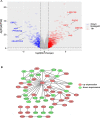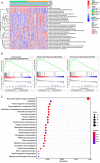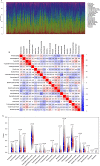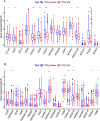Differences in genetics and microenvironment of lung adenocarcinoma patients with or without TP53 mutation
- PMID: 34635074
- PMCID: PMC8507221
- DOI: 10.1186/s12890-021-01671-8
Differences in genetics and microenvironment of lung adenocarcinoma patients with or without TP53 mutation
Abstract
Background: Differences in genetics and microenvironment of LUAD patients with or without TP53 mutation were analyzed to illustrate the role of TP53 mutation within the carcinogenesis of LUAD, which will provide new concepts for the treatment of LUAD.
Methods: In this study, we used genetics and clinical info from the TCGA database, including somatic mutations data, RNA-seq, miRNA-seq, and clinical data. More than one bioinformatics tools were used to analyze the unique genomic pattern of TP53-related LUAD.
Results: According to TP53 gene mutation status, we divided the LUAD patients into two groups, including 265 in the mutant group (MU) and 295 in the wild-type group (WT). 787 significant somatic mutations were detected between the groups, including mutations in titin (TTN), type 2 ryanodine receptor (RYR2) and CUB and Sushi multiple domains 3(CSMD3), which were up-regulated in the MU. However, no significant survival difference was observed. At the RNA level, we obtained 923 significantly differentially expressed genes; in the MU, α-defensin 5(DEFA5), pregnancy-specific glycoprotein 5(PSG5) and neuropeptide Y(NPY) were the most up-regulated genes, glucose-6-phosphatase (G6PC), alpha-fetoprotein (AFP) and carry gametocidal (GC) were the most down-regulated genes. GSVA analysis revealed 30 significant pathways. Compared with the WT, the expression of 12 pathways in the mutant group was up-regulated, most of which pointed to cell division. There were significant differences in tumor immune infiltrating cells, such as Macrophages M1, T cells CD4 memory activated, Mast cells resting, and Dendritic cells resting. In terms of immune genes, a total of 35 immune-related genes were screened, of which VGF (VGF nerve growth factor inducible) and PGC (peroxisome proliferator-activated receptor gamma coactivator) were the most significant up-regulated and down-regulated genes, respectively. Research on the expression pattern of immunomodulators found that 9 immune checkpoint molecules and 6 immune costimulatory molecules were considerably wholly different between the two groups.
Conclusions: Taking the mutant group as a reference, LUAD patients in the mutant group had significant differences in somatic mutations, mRNA-seq, miRNA-seq, immune infiltration, and immunomodulators, indicating that TP53 mutation plays a crucial role in the occurrence and development of LUAD.
Keywords: Genome; Lung adenocarcinoma; Microenvironment; Mutation; TP53.
© 2021. The Author(s).
Conflict of interest statement
No potential conflicts of interest were disclosed.
Figures






Similar articles
-
Integrative analysis of TP53 mutations in lung adenocarcinoma for immunotherapies and prognosis.BMC Bioinformatics. 2023 Apr 18;24(1):155. doi: 10.1186/s12859-023-05268-2. BMC Bioinformatics. 2023. PMID: 37072703 Free PMC article.
-
Specific TP53 subtype as biomarker for immune checkpoint inhibitors in lung adenocarcinoma.EBioMedicine. 2020 Oct;60:102990. doi: 10.1016/j.ebiom.2020.102990. Epub 2020 Sep 11. EBioMedicine. 2020. PMID: 32927274 Free PMC article.
-
A TP53 Related Immune Prognostic Model for the Prediction of Clinical Outcomes and Therapeutic Responses in Lung Adenocarcinoma.Front Immunol. 2022 Jun 28;13:876355. doi: 10.3389/fimmu.2022.876355. eCollection 2022. Front Immunol. 2022. PMID: 35837383 Free PMC article.
-
TP53 to mediate immune escape in tumor microenvironment: an overview of the research progress.Mol Biol Rep. 2024 Jan 25;51(1):205. doi: 10.1007/s11033-023-09097-7. Mol Biol Rep. 2024. PMID: 38270700 Free PMC article. Review.
-
A Candidate Cell-Selective Anticancer Agent.2013 Dec 12 [updated 2014 Sep 18]. In: Probe Reports from the NIH Molecular Libraries Program [Internet]. Bethesda (MD): National Center for Biotechnology Information (US); 2010–. 2013 Dec 12 [updated 2014 Sep 18]. In: Probe Reports from the NIH Molecular Libraries Program [Internet]. Bethesda (MD): National Center for Biotechnology Information (US); 2010–. PMID: 25506970 Free Books & Documents. Review.
Cited by
-
LINC02126 is a potential diagnostic, prognostic and immunotherapeutic target for lung adenocarcinoma.BMC Pulm Med. 2022 Nov 10;22(1):412. doi: 10.1186/s12890-022-02215-4. BMC Pulm Med. 2022. PMID: 36357869 Free PMC article.
-
Mechanism of Shishiwei Wendan Decoction in the Prevention and Treatment of Lung Adenocarcinoma Using Network Pharmacology and Molecular Docking.Biomed Res Int. 2022 Sep 23;2022:4411054. doi: 10.1155/2022/4411054. eCollection 2022. Biomed Res Int. 2022. Retraction in: Biomed Res Int. 2023 Dec 29;2023:9836034. doi: 10.1155/2023/9836034. PMID: 36193315 Free PMC article. Retracted.
-
Construction and validation of an efferocytosis-related prognostic signature in lung adenocarcinoma.J Cancer Res Clin Oncol. 2023 Nov;149(16):14577-14596. doi: 10.1007/s00432-023-05251-7. Epub 2023 Aug 14. J Cancer Res Clin Oncol. 2023. PMID: 37578523 Free PMC article.
-
Multi-omics profiling reveals PLEKHA6 as a modulator of β-catenin signaling and therapeutic vulnerability in lung adenocarcinoma.Am J Cancer Res. 2025 Jul 25;15(7):3106-3127. doi: 10.62347/NVVF8441. eCollection 2025. Am J Cancer Res. 2025. PMID: 40814363 Free PMC article.
-
Integrative analysis of TP53 mutations in lung adenocarcinoma for immunotherapies and prognosis.BMC Bioinformatics. 2023 Apr 18;24(1):155. doi: 10.1186/s12859-023-05268-2. BMC Bioinformatics. 2023. PMID: 37072703 Free PMC article.
References
MeSH terms
Substances
Grants and funding
LinkOut - more resources
Full Text Sources
Medical
Research Materials
Miscellaneous

